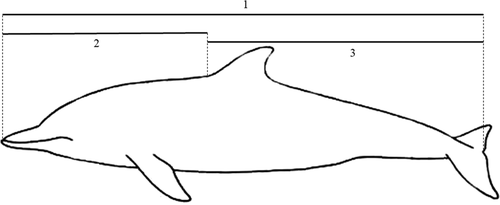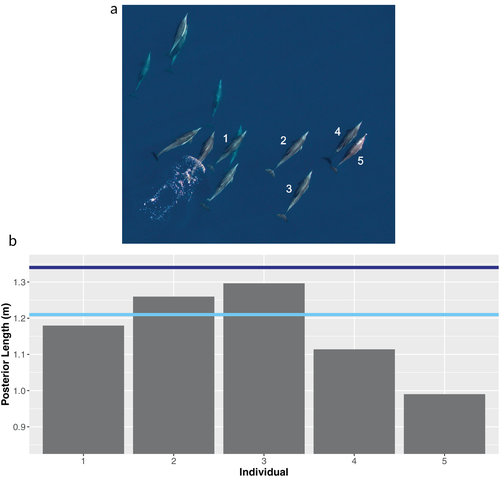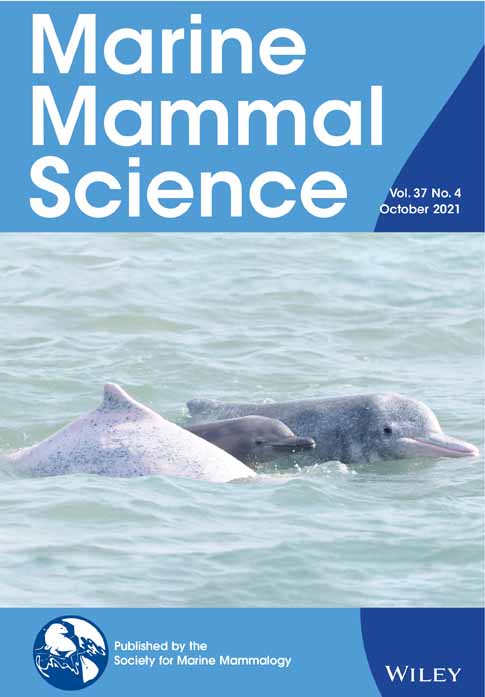Sexually dimorphic measurements from stranded and bycaught specimens contribute to the characterization of group composition in free-ranging common dolphins (Delphinus spp.) from aerial images
Short-beaked (Delphinus delphis delphis) and long-beaked (D. d. bairdii) common dolphins are the most commonly sighted cetaceans in waters off California (Barlow, 2016; Campbell et al., 2015; Carretta & Chivers, 2005; Heyning & Perrin, 1994). Despite the frequency of sightings, little is known about the demographic structure of their schools. This information is important for understanding risks: for example, D. d. delphis is the most commonly entangled species in California's thresher shark and swordfish drift gill net fishery (Carretta & Chivers, 2005; Carretta et al., 2017), and vulnerability to entanglement may be related to the sex of individuals (Danil et al., 2010; Perryman & Lynn, 1993). Additionally, there is evidence that male D. d. bairdii are more susceptible to domoic acid toxicity, which could be attributed to sex, age, or reproductive class segregation (Danil et al., 2021; de la Riva et al., 2013).
Information on the demographic structure in free-ranging schools of these two subspecies is mostly limited to noting presence or absence of calves, which can be distinguished from other individuals by their smaller total length and close association with another dolphin presumed to be their mother (Cañadas & Hammond, 2008; Chivers et al., 2016; Perryman & Lynn, 1993). Reproductively mature male Delphinus spp. can be identified via the presence of a postanal hump, a keel between the anus and the flukes (Heyning & Perrin, 1994; Neumann et al., 2002). However, the postanal hump is located on the underside of the body, making identification of sex difficult from the typical vantage point of a boat-based observer. Previous studies have characterized sex composition of another small delphinid, Cephalorhynchus hectori, through molecular analysis of biopsy samples (Oremus et al., 2013) and by using an underwater pole-mounted camera system to determine sex (Webster et al., 2009). In D. d. delphis and D. d. bairdii, determination of sex composition using biopsies is of more limited utility, since the large group sizes typical of both subspecies render sampling an entire group impossible. Furthermore, sex-specific behaviors might affect the likelihood of an individual of a particular sex being biopsied (Kellar et al., 2013). Similar sampling considerations also apply to boat-based underwater camera systems with these subspecies.
This study suggests the potential of photogrammetric measurements from aerial images to fill key data gaps on common dolphin group composition. Aerial photogrammetry from manned aircraft has been used routinely to measure body size of cetaceans (Fearnbach et al., 2011; Fortune et al., 2012; Pitman et al., 2007), including Delphinus spp. (Chivers et al., 2016; Perryman & Lynn, 1993). Additionally, drones now offer more opportunities for photographically sampling cetaceans from the air (Durban et al., 2015), with the benefit of minimizing disturbance (Christiansen, Rojano-Doñate, et al., 2016). Drones are increasingly being used to obtain precise morphometric measurements of cetaceans (Christiansen et al., 2020; Christiansen, Dujon, et al., 2016; Dawson et al., 2017; Durban et al., 2016; Fearnbach et al., 2020; Groskreutz et al., 2019), providing an opportunity to characterize demographic school composition of large dolphin schools. Here we present an example of how data from stranded and fisheries bycaught common dolphins can be used to develop sexually diagnostic measurements of Delphinus spp. in Southern California and demonstrate how these measurements can be applied to drone-derived aerial images of free-ranging individuals to provide information on demographic composition.
Measurements were taken from stranded and bycaught D. d. delphis and D. d. bairdii collected from the waters off California (32°–42°N, 126°–117°W) between 1962 and 2018 (Chivers, 2018). Three criteria were developed to identify measurements that could be identified and measured accurately in aerial photographs. To be considered, the measurement had to: (1) be restricted to the dorsal side of the body, (2) have start and end points easily distinguishable in aerial photographs, and (3) reflect a part of the body that is at times flat when viewed vertically while the animal is swimming. Although error associated with photogrammetric measurements tends to be small (Dawson et al., 2017; Scott & Perryman, 1991), the smaller the measurement, the greater the influence of this measurement error. Accordingly, we avoided measurements that were typically less than 50 cm (e.g., rostrum length). As a result, three morphometric measurements were selected: standard total body length (hereafter “total length”), an “anterior” length measurement from tip of the rostrum to anterior insertion of the dorsal fin, and a “posterior” length measurement between the anterior insertion of the dorsal fin and the fluke notch (Figure 1). If field and laboratory measurements were available for the same specimen, preference was given to laboratory measurements (following Chivers, 2018; Norris, 1961). To identify sexually dimorphic measurements, adult specimens were identified by total length, as defined in Heyning and Perrin (1994; Table 1), who used physical maturity (fusion of all vertebral epiphyses to the centra) or proxies thereof (sexual and cranial maturity combined) to classify specimens as adults. Sample sizes stratified by sex and species are provided in Figure 2.

| Male | Female | |
|---|---|---|
| D. d. bairdii | 202–235 cm | 193–224 cm |
| D. d. delphis | 172–201 cm | 164–193 cm |

All three measurements exhibited interspecific differences (Figure 2). Specifically, D. d. bairdii had longer median lengths than D. d. delphis in all three measurements. However, the measurements varied in the extent of sexual dimorphism within subspecies. For each measurement, we quantified sexual dimorphism by calculating the percentage of adult males that were longer than 95% of the adult females. For both subspecies, posterior length showed the greatest degree of sexual dimorphism, as 58.7% and 37.3% of adult D. d. bairdii and delphis males, respectively, were longer than 95% of adult females. Total length showed the next greatest degree of sexual dimorphism (D. d. bairdii: 45.5%; D. d. delphis: 34.7%), driven largely by the component contributed by posterior length, and anterior length showed the lowest degree of sexual dimorphism (D. d. bairdii: 22.7%; D. d. delphis: 2.0%).
To demonstrate the application of these metrics, we generated photogrammetric measurements from free-ranging dolphins at sea, sampled in an aerial image collected by an octocopter drone (APO-42; Aerial Imaging Solutions, New Lyme, CT) launched from a 20 m boat that approached dolphin groups from horizontal distances of approximately 300 m. The drone carried a micro 4:3 digital camera (Olympus E-PM2) and flat lens (Olympus M.Zuiko 25 mm f1.8) in a gimbaled mount to collect vertical images of dolphins from an altitude of ~60 m to provide a water-level pixel resolution of <2 cm (Durban et al., 2015). Pixel measurements of dolphin morphometrics were converted to distance units using their ratio to the known size of the camera sensor (4,608 pixels = 17.3 mm wide) and were then scaled to true size (scale = altitude/focal length) using an onboard laser altimeter with typical error of ~0.1% (Dawson et al., 2017). The fluke notch is often difficult to distinguish in aerial images. Instead, the trailing edge of the fluke was marked, adding an estimated 2.5 cm to posterior length (Perryman & Lynn, 1993). For this study, this was considered too small a difference to affect interpretation of the data.
In the example image shown in Figure 3a, the anterior insertion of the dorsal fin was clearly visible, confirming the ability to measure anterior and posterior lengths in aerial photographs, as well as total length, despite a camera altitude of 58 m (190 ft). In this example image, five individuals were considered flat enough for approximately unbiased measurements. Two of the five measured individuals had a posterior length longer than 95% of the analyzed stranded and bycaught adult females (Figure 3b). As such, we concluded these individuals were likely males.

Our results will facilitate characterization of group composition in aerially photographed Delphinus spp. schools off Southern California. Here we demonstrated the ability of this method to identify likely large adult males in one example aerial image. This image was collected during ongoing photogrammetry sampling that collected several hundred to nearly 2,000 images for each school sampled. We anticipate that, by applying the methods detailed here to all images from the same school, we will be able to measure the length composition of a large portion of individuals within the school. In addition to estimating the length distributions, we will also now be able to identify likely large adult males, providing greater insight into the demographic composition of schools.
ACKNOWLEDGMENTS
We are grateful to the NOAA/SWFSC stranding team and the California gill net fishery observers who collected and/or measured carcasses. Research on stranded and bycaught dolphin carcasses conducted under the stranding agreement from NOAA Fisheries and research permit number #19091-03. We are also grateful to everyone who participated in the linked projects N00014171313 and N0001418IP00021 funded by the U.S. Office of Naval Research, which provided the dolphin image, specifically the principal investigator Brandon Southall. The aerial image of dolphins was collected during research authorized by NMFS permit #19091.
AUTHOR CONTRIBUTIONS
Lisa Ballance: Project administration; resources; supervision; validation; visualization; writing-review & editing. Trevor Joyce: Methodology; software; writing-review & editing. John Durban: Conceptualization; funding acquisition; investigation; methodology; project administration; resources; supervision; visualization; writing-review & editing. Samantha Leander: Data curation; formal analysis; investigation; methodology; visualization; writing-original draft; writing-review & editing. Holly Fearnbach: Conceptualization; investigation; methodology; writing-review & editing. Kerri Danil: Conceptualization; data curation; investigation; resources; writing-review & editing.




